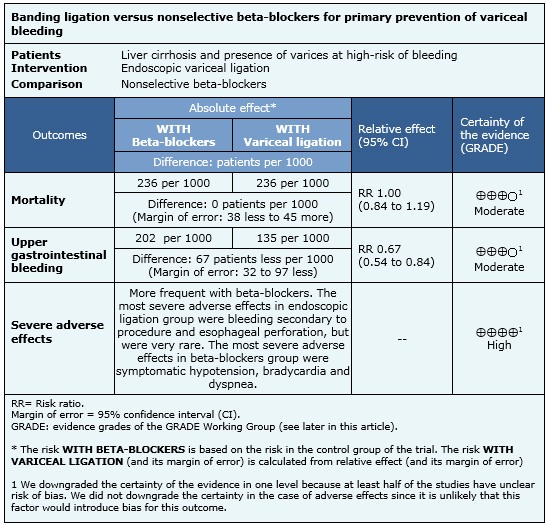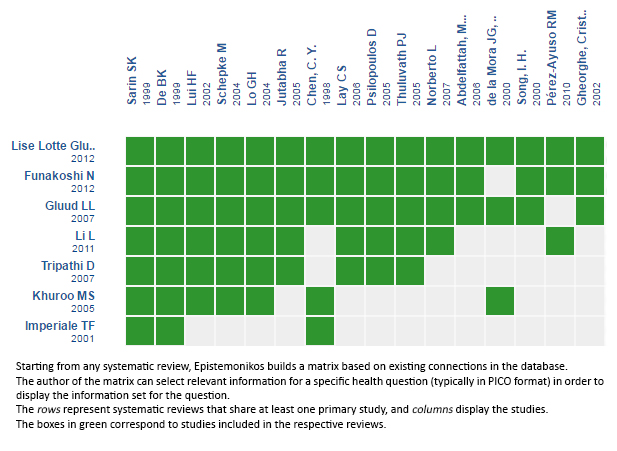Epistemonikos summaries
← vista completaPublished on October 4, 2016 | http://doi.org/10.5867/medwave.2016.6564
Banding ligation or beta-blockers for primary prevention of variceal bleeding?
¿Ligadura endoscópica o betabloqueadores para profilaxis primaria de hemorragia variceal?
Abstract
Variceal bleeding is one of the most serious complications of liver cirrhosis. Nonselective beta-blockers and endoscopic ligation are considered effective strategies for primary prevention of variceal bleeding, but there is no consensus about which alternative constitutes the best option. Searching in Epistemonikos database, which is maintained by screening 30 databases, we identified seven systematic reviews including 21 randomized controlled trials addressing the question of this article. We combined the evidence using meta-analysis and generated a summary of findings following the GRADE approach. We concluded variceal ligation probably decreases the risk of variceal bleeding and it is associated to less adverse effects when compared with nonselective beta blockers, although probably there is no difference in terms of mortality.
Problem
Gastro-esophageal varices are common in liver cirrhosis. The prevalence in stable cirrhosis varies between 30 and 40%, while in decompensated cirrhosis it reaches 60%. In patients with varices, the annual risk of bleeding is estimated at 30%, with a mortality rate ranging from 20 to 50% in each episode [1]. Nonselective beta-blockers are low-cost drugs that have proven effective in preventing variceal bleeding [2],[3], through reduction in porto-systemic pressure gradient, an important factor conditioning the rupture of varices. However, some patients do not tolerate them because of adverse effects. On the other hand, endoscopic ligation with elastic bands also prevents variceal bleeding in high risk patients [4],[5], but they have a higher cost, are more difficult to implement and have other associated risks. The aim of this article is to summarize the evidence comparing both prophylactic alternatives in patients with liver cirrhosis and high risk of variceal upper gastrointestinal bleeding.
Methods
We used Epistemonikos database, which is maintained by screening more than 30 databases, to identify systematic reviews and their included primary studies. With this information we generated a structured summary using a pre-established format, which includes key messages, a summary of the body of evidence (presented as an evidence matrix in Epistemonikos), meta-analysis of the total of studies, a summary of findings table following the GRADE approach and a table of other considerations for decision-making.
|
Key messages
|
About the body of evidence for this question
|
What is the evidence. |
We found seven systematic reviews [1],[4],[5],[6],[7], [8],[9] including 21 randomized controlled trials reported in 26 references addressing the question of interest [10], [11],[12],[13],[14],[15],[16],[17],[18],[19],[20],[21], [22],[23],[24],[25],[26],[27],[28],[29],[30],[31],[32], [33],[34],[35]. |
|
What types of patients were included |
All of the studies included patients with liver cirrhosis and presence of high-risk of bleeding varices, either by their large size (grade III or IV) or red spots. |
|
What types of interventions were included |
Eighteen trials [10],[12],[14],[15],[16],[17],[18],[19], [20],[21],[22],[25],[29],[30],[31],[32],[33],[34], used propranolol as beta-blocker, one trial [26] used nadolol, another [28] used carvedilol and one study [35] did not report the type of beta blocking agent used. Nine studies [12],[14],[19],[21],[25],[29],[30],[31],[34], conducted more than three ligation sessions and four studies [16],[17],[26],[28] performed fewer than three sessions. The other eight studies [10],[15],[18],[20],[22],[27],[32],[33] did not report the number of ligation sessions. Follow-up was longer than 1 year in all studies. |
|
What types of outcomes |
The studies measured multiple outcomes, however those incorporated by most systematic reviews were: Overall mortality, bleeding related mortality, upper gastrointestinal bleeding from any cause and adverse effects. |
Summary of findings
The information on the comparison between nonselective beta-blockers and ligation in primary prophylaxis of variceal bleeding is based on 21 randomized controlled trials involving 1659 patients. Twenty trials measured overall mortality (one study did not report this outcome [35]), 14 studies measured upper gastrointestinal bleeding from any cause and 10 studies evaluated adverse effects. The summary of findings is as follows:
- Primary prophylaxis with variceal ligation probably has little or no effect on the risk of mortality compared with nonselective beta blockers. The certainty of the evidence is moderate.
- Primary prophylaxis with variceal ligation probably reduces the risk of bleeding compared with nonselective beta-blockers. The certainty of the evidence is moderate.
- Primary prophylaxis with variceal ligation is associated to fewer adverse effects in comparison to nonselective beta-blockers. The certainty of the evidence is high.


Other considerations for decision-making
|
To whom this evidence does and does not apply |
|
| About the outcomes included in this summary |
|
| Balance between benefits and risks, and certainty of the evidence |
|
| What would patients and their doctors think about this intervention |
|
| Resource considerations |
|
|
Differences between this summary and other sources |
|
| Could this evidence change in the future? |
|
How we conducted this summary
Using automated and collaborative means, we compiled all the relevant evidence for the question of interest and we present it as a matrix of evidence.

Follow the link to access the interactive version: Banding ligation versus beta-blockers for primary prevention of variceal bleeding.
Notes
The upper portion of the matrix of evidence will display a warning of “new evidence” if new systematic reviews are published after the publication of this summary. Even though the project considers the periodical update of these summaries, users are invited to comment in Medwave or to contact the authors through email if they find new evidence and the summary should be updated earlier. After creating an account in Epistemonikos, users will be able to save the matrixes and to receive automated notifications any time new evidence potentially relevant for the question appears.
The details about the methods used to produce these summaries are described here http://dx.doi.org/10.5867/medwave.2014.06.5997.
Epistemonikos foundation is a non-for-profit organization aiming to bring information closer to health decision-makers with technology. Its main development is Epistemonikos database (www.epistemonikos.org).
These summaries follow a rigorous process of internal peer review.
Conflicts of interest
The authors do not have relevant interests to declare.

